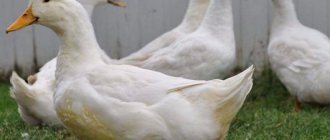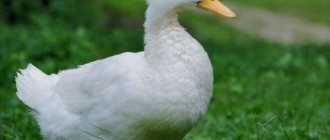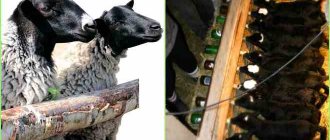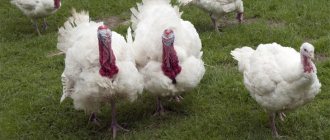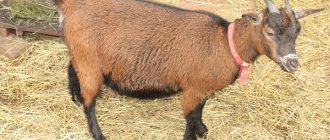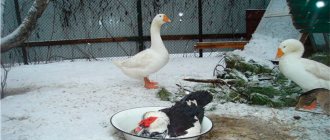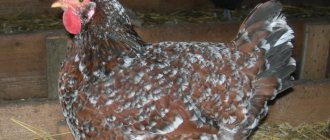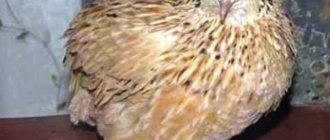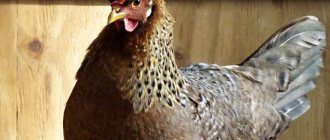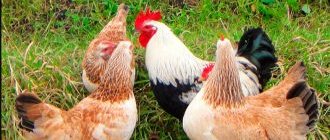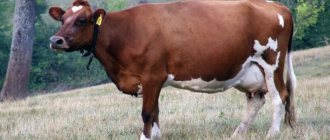Domestic ducks are of great interest for breeding in private backyards. They quickly fatten up, almost never get sick, adapt well to different climatic conditions, and eat everything they are given. The most common breed in Russia is the Peking duck; it can most often be found in private estates. This choice is not accidental: this breed is distinguished by a number of outstanding characteristics that attract many duck breeders to it. Let's look at what they are and how to properly raise this bird at home.
History of origin and distribution
The Peking breed of domestic ducks was bred more than 300 years ago in China and brought to Europe in 1873. Currently widespread in the world and, being highly productive and one of the best meat breeds, it has supplanted many other breeds.
Peking ducks have been used to create several other breeds.
In Soviet times, Peking and crosses of this breed accounted for more than 90% of the pedigree duck population on collective and state farms.
In modern Russia, the main poultry population in large duck farms still belongs to the Peking breed.
Molting, its features
There is a certain order in which ducks shed their feathers. The change first affects the abdominal area. Next, feathers fall out on the lower neck and chest. After a few days, the plumage begins to disappear on the front of the back. The change of plumage occurs faster and ends when almost half of all feathers are gone. Last but not least, this concerns the hip area.
The flight feathers emerge starting from the inner edge of the wing and further along the body. Molting occurs in summer and autumn. The intensity of the fallout is the same. Each time the process takes approximately 60 days. The so-called juvenile molt, when Pekin ducks shed their front feathers, begins at the age of 71 days. This affects ducklings that have limited range of range more intensely.
Description of the breed
Photo:
The Peking duck can always be distinguished from its fellows due to its exterior features:
- the weight of males is 3.6-4.2 kg, females 3.4-3.9 kg.
- powerful physique, strong bones;
- wide chest;
- the back is large;
- on the large head there is a characteristically convex forehead;
- the beak has a bright orange color;
- wings with good span have excellent development;
- the neck is small and not very long;
- the tail is small, raised up, the feathers on the tail are usually slightly curled;
- legs are strong, low, set wide apart;
- eyes black, small;
Mostly there are ducks with thick snow-white plumage, but there are also representatives with a cream color.
The Peking duck breed has a calm character, it quickly gets used to breeders, recognizes them, and therefore does not rush or get scared when it’s time to feed or if the breeder simply walks into the poultry house.
However, the bird's nervous system leaves much to be desired. They are easily excitable and can become nervous with minor changes in content. The breed is excellent for keeping at home.
What are the disadvantages of the breed?
We recommend reading our other articles
- Grape variety Isabella
- Description of the cabbage variety Slava
- How to store potatoes in the cellar
- Flower pots
Experienced breeders who are accustomed to dealing with this breed may not notice its shortcomings at all. However, inexperienced, young breeders need to know that the Peking duck does not tolerate dampness and drafts in the poultry house at all, and females are bad mothers. They do not like to incubate eggs, and they do not particularly care about their offspring.
Important!
The Pekingese breed is very noisy; breeders note that it can make noise even without a seemingly significant reason. He reacts very sharply to any stressful situation. Weight may decrease, females stop laying eggs, and if they do, they are unfertilized.
Price
Let's compare prices for live Peking duck from three producers in the country.
To do this, we will study the proposals in farms of three cities - St. Petersburg "Gatchina Farmer", Ryazan "Lukin's Compound" and Moscow "Goose Farm" (despite the name, this farm sells not only geese, but also ducks , as well as other types of poultry).
Thus, the farm “Gatchina Farmer” will ask 1,200 rubles per piece for an adult Peking duck aged 10 months. The price for ducklings is 120 rubles per piece.
“The Lukins’ Compound” in the city of Ryazan tells us the following prices:
- The price for ducklings is 350 rubles .
- Adults – 2,500 rubles .
As you can see, the prices of this farm are several times higher than those of their St. Petersburg colleagues. Finally, one of the most affordable options for live duck prices when analyzing large producers turned out to be the Moscow Goose Farm.
The following data is presented here:
- The price for ducklings is 60 rubles.
- Adults – 500 rubles.
Practical aspects of maintenance, care and feeding
With proper care, the bird grows and develops intensively in any climate zone! At the same time, it produces healthy meat, eggs and valuable recyclable materials (feather, fat).
There are several types of farms specializing in raising ducks:
- with a completed production cycle;
- with an incomplete production cycle.
In the first case, all workshops are present - a hatchery, a fattening workshop, a parent herd, etc. In farms of the second type, the main goal is to obtain marketable products, for example, fattening purchased day-old young stock.
Some rely on the sale of breeding birds raised in their own hatchery.
By the way, poultry products obtained from private household plots are in greater demand than farm products. The fact is that farmers feed poultry with factory-made feed containing growth stimulants and other components that are potentially hazardous to health.
One of the guarantees of successful duck rearing is the sex ratio. There should be up to four females per drake
This point is worth paying attention to for those who plan to receive hatching eggs.
Reviews
According to farmers, the advantages include the following:
- the bird tolerates both heat and cold well;
- undemanding to the food supply;
- young animals are characterized by early maturity;
- the presence of a pond does not play an important role in duck breeding.
The disadvantages of the breed are:
- lack of maternal instinct;
- ducks are very sensitive to excess moisture.
With proper maintenance and feeding, a large amount of production from Peking ducks is guaranteed.
Advantages and disadvantages of Beijing
The main advantages of the breed, thanks to which the Pekingese variety is popular all over the world:
- early maturity and rapid growth of young animals;
- unpretentiousness, ability to adapt to various conditions;
- high egg production and quality of hatching eggs.
Disadvantages include the bird's loudness, lost maternal instinct and early greasiness of the carcass.
The Peking duck is considered one of the most popular breeds. Poultry farmers value it for its tasty meat, high productivity, rapid growth, unpretentiousness in nutrition and good egg production. The poultry farmer is required to provide adequate feeding, antibiotics and a clean, warm barn.
Meat productivity
Peking duck meat is very soft, nutritious and juicy. Fat content depends on the quality of feeding and the age of the bird. The older the individual, the fattier its meat will be.
An adult drake has a live weight of about 4 kg, and in some cases a higher weight gain can be achieved. Ducks weigh a little less - about 3 kg.
Ducklings quickly gain weight if the necessary feeding conditions have been met: intensive feeding and a balanced diet. The final ratio of meat to slaughter weight is 70/30%.
Raising ducklings
Nature did not instill maternal instinct in this breed, and therefore the Peking duck does not want to hatch chicks. However, ducklings, like adult ducks, have good survival rate, and therefore raising them will not be difficult.
The temperature in the incubator should not be lower than +30. If it is not possible to breed birds in an incubator, it is necessary to properly equip and insulate an ordinary box: wrap it in warm cloth, put a heating pad inside, and turn on a heating lamp. The most important condition is to avoid dampness and coolness! Place a mat on the floor and create constant circulation of fresh air in the room.
The basis of the diet for fattening small Peking ducklings is grain mixtures, cottage cheese, boiled eggs and potatoes. For the first 10 days, feed the chicks 5-6 times a day, starting at 6-7 am, then the number of “lunches” can be reduced to 4.
An excellent addition to the diet will be mineral supplements - crushed shells and eggshells, chalk, wood ash. From the garden, feed small birds with carrot tops, cabbage leaves, clover and dandelions.
To maintain the muscle mass of young Peking ducks, meat flour and chopped meat products, pre-heat-treated, are suitable.
You can release small ducklings to a pond without the accompaniment of their parents as early as two weeks after birth, provided that the descent will not be dangerous.
Breeding
Incubation mode for Peking duck eggs by day:
The main problem in breeding Peking ducks is the lack of maternal instinct in females. This prevents them from hatching eggs and caring for their offspring.
For this reason, to breed the breed, you need a good and preferably automatic incubator, as well as time that will need to be spent on young offspring after the birth of the ducklings.
If the breeder has such capabilities, then breeding will not cause problems. The most popular are the Cinderella and Laying incubators.
Ducklings are kept in a brooder or a special room where there is an artificial heating system, artificial lighting, ventilation, no drafts, no dampness.
Up to 12 young ducklings can be placed per square meter. In the first week, the temperature in the room is maintained at +30 degrees, but from the 2nd week it needs to be lowered to room temperature so that the ducklings get used to normal ambient temperatures.
Important! The brooder with ducklings should always be clean! This is extremely important to reduce bird mortality and accelerate its growth and development. From an early age, the Peking duck is distinguished by its mobility, curiosity, and good appetite.
Young ducklings have a strong immune system. For any deviations, you must contact a veterinarian. If a bird is frail, slow, or eating poorly, it must be immediately isolated and shown to a veterinarian.
The diet of young ducklings initially consists of soft, nutritious food. It can be a boiled egg, cottage cheese, porridge made from crushed steamed grain. In small quantities, you can initially feed soft grass such as nettles and dandelions.
From the second week, they include more greens, and they stop producing eggs altogether. Compound feed for young birds is introduced, steamed porridge, to which premixes must be added in small quantities.
Ducks are transferred to normal nutrition from 3-4 weeks.
Maintenance and cultivation at home
Breeding meat ducks at home is not a difficult task. To fatten young animals, it is enough to build a pen and a shed on the site. The presence of pasture and a pond will significantly reduce the cost of poultry feed, since ducks eat vegetation well, including aquatic vegetation. They are quite smart, able to independently find their way from home to a reservoir and back, if the path does not exceed a kilometer.
Selection of young animals
Farmers and large poultry farms that specialize in raising waterfowl offer day-old and raised chicks to poultry farmers. It is better to buy ducklings directly from the manufacturer, rather than from a reseller. The latter often buy rejected young animals from farms that are stunted in growth and pass them off as younger chicks.
Purchasing day-old young animals is the best option from a safety point of view. The duckling, which was recently taken out of the incubator, has not yet been fed, its digestive system is sterile. The chick immediately gets used to the food that the new owner offers him, there is no stress from the change in food. Day-old babies are less susceptible to stress and can easily tolerate transportation.
When buying day-old ducklings, you must remember that they need a temperature of at least +30...+33 degrees, and the babies cannot be overcooled. Ducklings are transported in insulated boxes, making sure that they do not crush each other.
A good one-day-old duckling weighs about 80 g, its down is yellow and clean. The eyes are clear, the nostrils are clean.
There is no need to be afraid of greenish droppings in one-day-old babies, this is a natural phenomenon - the residual yolk leaves the body. Once feeding begins, the litter will return to normal.
When purchasing raised young animals, poultry farmers are most often offered Peking at the age of 2 weeks. At this time, the bird is partially feathered and weighs at least 400 g. Healthy chicks are nimble, actively respond to food, and squeak loudly. Their down and feathers are not stained with droppings. You should not buy lethargic, inactive ducklings.
According to sanitary standards, purchased young animals should not be placed in a common barn with existing birds. Purchased ducklings are kept separately for at least a month.
Premises requirements
To maintain the parent flock, simple sheds are built from wood or foam blocks. The area of the room should allow for 1 square meter. m 3 for birds. Feeders and drinking bowls are installed inside the duckling house. Nests in the form of houses or boxes are placed in the spring, when egg laying begins.
This is achieved with the help of electric heaters, IR lamps, and wood stoves.
The light in winter is not bright for the bird; it is not recommended to artificially lengthen the daylight hours, so as not to provoke an early start of egg laying.
Ducks produce a lot of dampness because after each meal they go to the water bowl to rinse their beaks with water. There are several ways to reduce humidity in a shed:
- install drinking bowls of a special design to prevent water from splashing onto the floor;
- periodically turn on the fan heater in the duck house to dry the air;
- use a thick layer of litter, updating it frequently.
Straw and large wood shavings are suitable as bedding for ducks. Some poultry keepers keep the birds on mesh floors, the space under which is concreted, provided that a drain is made to drain the liquid.
A small number of birds can be housed in a polycarbonate greenhouse for the winter. There the ducks will be warm and light. They will thoroughly fertilize the soil surface, saving the owner from the need to specially bring fertilizers into the greenhouse.
What and how to feed Peking duck
The basis of the diet of ducks of this variety is grain: wheat, barley, corn, oats, peas. The summer poultry menu can contain up to 60% fresh grass and aquatic vegetation - duckweed. For the winter, nettle brooms, small-stemmed hay, and vegetables are prepared for ducks: carrots, pumpkin, beets, cabbage. You can also include food waste in your menu.
The diet of breeding birds and young animals for fattening differs significantly. Due to the tendency to obesity, the parent flock is fed strictly according to the norm, giving preference to greens and vegetables.
Approximate diet of the Beijing laying hen in spring and summer:
- grain mixture consisting of crushed oats, barley, corn and wheat - 180 g;
- wheat bran - 20 g;
- hay flour - 40 g or fresh grass ad libitum;
- raw vegetables - 100 g (not given in summer);
- salt - 1.5 g;
- shell, chalk, eggshell - 10 g.
The bird most readily eats wet, crumbly mash. Instead of water, you can use vegetable broth, meat broth, or whey.
Fattening ducklings are fed intensively; the content of digestible protein in the diet should not be lower than 18 units. They use specialized feeds: Start, Growth, Finish. You can independently prepare mixtures from crushed grains, herbs, and cottage cheese.
Sample menu for Peking ducklings aged from 1 to 7 days:
- mixture of corn grits, eggs and wheat - 10–30 g;
- boiled chopped egg - 5–8 g;
- cottage cheese - 5–7 g;
- dandelion greens, quinoa, clover - 10 g.
From a week of age to 20 days, the grain norm is increased to 80 g per head, greens are given in abundance. Cottage cheese and eggs are no longer fed. Adding whey or skim milk to the mash has a positive effect on weight gain.
Shortly before slaughter, at the age of 50-60 days, ducklings are fed a mash of crushed corn and wheat - 150-180 g per “beak”. Give plenty of greens.
Rules of care
Ducks should be fed at least 3 times a day; young animals should have food available all the time. The peculiarity of the structure of a duck's crop is that it has a small capacity. The bird cannot eat enough for future use and sits hungry during long intervals between meals.
The design of drinking bowls for livestock should be such that the duck can rinse its beak, flushing the nasal openings from food residues. The cleanliness and availability of water must be constantly monitored.
A pond for birds is not required, but desirable. By swimming and eating aquatic vegetation, they enjoy and grow better.
Content
A characteristic feature of this breed is a very high rate of weight gain, however, there is one peculiarity. It is profitable to keep birds until the first feather change, which is why young animals are prepared for slaughter from 60 to 90 days of life.
With the onset of the molting season, productivity indicators drop noticeably, which means that all the costs of food are simply not justified. Another factor in early slaughter is the quality of meat products; it is the young animals that have a very delicate taste.
After the change of feathers occurs, the birds' internal organs begin to grow rapidly, and a new feather cover is formed. At this time, ducks are more difficult to pluck after slaughter, and many farmers note a deterioration in the taste of the resulting meat.
When breeding Pekingese, you should pay close attention to one breed feature. These birds have accelerated metabolic processes and a small intestinal size.
The last factor determines the very rapid digestibility of feed, which takes approximately 4 hours. Because of this feature, feeders should always be filled with food.
A special room will have to be allocated for keeping Pekin ducks, especially in winter. An outbuilding is quite suitable; if there are holes, they need to be repaired, as well as possible cracks.
It is recommended to make the floors concrete. This material has a number of advantages over short-lived wood.
Ducks consume quite a large amount of water, which spills on the floor, and accordingly, sooner or later the boards will begin to rot. A layer of straw or sawdust must be used on top of the concrete.
Room temperature and light availability play an important role. With the onset of cold weather, the thermometer should show at least +10 degrees, and in hot weather no more than +25 °C. Deviation from these indicators affects the productivity of Peking ducks.
In winter, when natural light is reduced, lamps are turned on so that there is at least 13 hours of daylight.
Keeping ducks in summer is less troublesome; they are provided with a walking space equipped with canopies that protect the feeding area and provide shade for the birds. At the same time, the entrance to the room is not blocked, so that in case of bad weather or at nightfall the ducks can go inside.
It is imperative to install containers with water outside so that the birds can use it for their own purposes. Ideally, if the farm has a small natural pond, its presence significantly reduces feed costs. Ducks happily eat mud, which gives them an additional source of nutrition.
How to keep Peking ducks?
Keeping Peking ducks does not cause any difficulties. They are not demanding in terms of care or conditions, but this breed reacts very poorly to any changes in maintenance or feeding, so it is necessary to provide it with normal conditions from the first days and maintain them all the time.
- The Peking duck very quickly acclimatizes to new conditions. She calmly endures both heat and cold.
- The poultry house is arranged according to the number of individuals. There are 1.5-2 ducks per square meter. The floor must rise 25 cm from ground level. This protects the birds from rodents and winter cold. Inside the room there must be normal ventilation, windows, and an artificial lighting system.
- There should be one nest for 1-3 individuals. Sizes 40-50 cm. They can be made from old baskets, plywood, boxes, etc.
- The walk should be planned in size so that there is room for the birds. Herbs are sown inside. In winter, it is recommended to clear the snow from the enclosure and cover it with a thick layer of straw so that the ducks can be released for walking on the sunniest, warmest days, without precipitation or severe frosts.
- Reservoirs are not required for maintenance. Even without them, the Peking duck will feel good. You can simply occasionally place a large basin of water in the walking enclosure so that the birds can swim in it.
- Slaughter is carried out before molting, 2 months after birth, since after molting the presentation of the carcass will be less attractive.
Cleaning is carried out as the poultry house gets dirty. The bedding should be changed as soon as it gets dirty, as dirt is the most effective method of spreading disease indoors.
Feeding
Ducklings can be fed in two ways, using wet or dry food.
In the first method, dry grain food is steamed with hot water until it reaches the consistency of porridge, and then chopped green grass, duckweed, and vegetables are added.
The dry type primarily includes ready-made feed.
Because of their high cost, farmers prefer to make such food with their own hands; for this they take:
- oats;
- millet;
- corn;
- wheat.
Each owner chooses what to offer the ducklings, but it is important that grain and corn are mandatory components. Dry food is given at least five times a day; it is important that with this type of feeding the young animals always have fresh water available.
Newly born ducklings are fed boiled, finely chopped or grated eggs; from the third day, you can cook the millet until crumbly and add the egg.
Some owners give porridge based on milk or broth from fish and meat. But such feeding is acceptable for ducklings that have reached two weeks of age.
The freshness of the feed plays an important role; stomach diseases can develop from sour mash, which will cause a lot of trouble for the farmer. Shell rock or fine gravel is given in separate containers.
The feeding diet varies depending on the season.
With the onset of cold weather, the feed becomes somewhat smaller, and they are fed twice a day - in the morning and in the evening. At the first feeding, you can offer wet mash, as well as combined silage; the second time, add a dry grain-flour mixture.
In winter, it is important to give boiled vegetables, herbal meal and fish meal as a mineral supplement. It would be useful to have good quality hay, which will serve as a substitute for grass, but in small quantities.
In summer, it is good to provide birds with access to open water. They will find on their own the required amount of food from duckweed, mud and algae.
If this is not possible, then a pasture will do, where the ducks will feed on the green mass. With this type of diet, grain mixtures are given twice a day - in the morning and in the evening.
When kept without walking, Pekingese are transferred to four feedings a day. Grain is given in the morning and evening hours; during the day, a wet mash is fed, which includes aquatic vegetation.
You need to prepare wet food in such a way that the ducks eat it at one time, otherwise in extreme heat it will simply spoil. Fresh green mass is given to birds throughout the summer.
Despite their excellent appetite, Peking ducks need to change their food very carefully; birds are extremely sensitive to changes in diet.
With a sharp transition from one type of diet to another, productivity noticeably decreases, the ability to lay eggs in some cases disappears, and the change of feathers does not occur at the right time.
How to feed Pekin ducks?
Feeding is usually chosen according to the breeder's capabilities. Of course, the higher quality the food, the better for the bird, but the Peking duck is not picky when it comes to nutrition. Even on cheap food, she fattens well and gives good productivity indicators.
The diet usually includes more protein foods, since the breed belongs to the meat category and in this case it is mandatory if the breeder wants to get tasty, not tough meat in small quantities. Pekingese eat anything. They eat plant and animal food with great appetite. So the diet can be made up of plant products (greens, vegetables, fruits) with an admixture of insects, meat and bone meal, table scraps and other things. However, to increase productivity, premixes are necessarily added to food.
The metabolism of Peking ducks is very fast with a rather small intestine, so the absorption of food eaten occurs quickly. In this regard, it is necessary to provide the bird with nutritious food with an abundance of vitamins and minerals. Of course, the nutritional value must also be high, otherwise the Peking duck simply will not get enough of it. There are two options for feeding these birds.
- Uninterrupted. There should always be food in the feeder so that the ducks can eat when necessary and do not go hungry. The problem is that this is very expensive, so such nutrition is provided only if there is cheap food or by feeding simple homemade food (grain porridge, mash, without compound feed).
- 4-5 meals a day. The diet consists of nutritious, fortified food. A mandatory component must be high-quality feed. The rest is a mixture of cereals, herbs, vegetables, and root vegetables. The food turns out to be satisfying and nutritious, so the birds want to eat less, in addition, the necessary dose of vitamins and minerals comes with the food.
Important!
You can save on feeding Peking ducks simply by providing them with good walking. On walks they can eat a lot of grass, greenery like duckweed. Thus, during walks, the breeder does not need to spend money on feeding at all and the number of feedings is reduced to 2 times (morning and evening).
Peking ducks in an aviary
Diseases and their treatment
Vitamin deficiency
Despite the fact that Pekin ducks are a resistant breed of birds, they are still susceptible to some diseases:
Avitaminosis
With vitamin deficiencies, birds become lethargic, loss of appetite, coordination of movement is impaired, growth slows down, wings sag, eyes become inflamed, convulsions appear and fluid is released from the nostrils. A lack of vitamin D can lead to rickets.
A balanced diet is the only way to combat vitamin deficiency, and if a bird develops symptoms of the disease, it means there is a deficiency of some element in the feed.
Goiter diseases
The cause of the disease may be sticky food, ingestion of foreign objects or large food. If the bird is not helped immediately, the disease may become chronic and the goiter will stop shrinking.
If the crop is blocked, you should try to clear it yourself, holding the duck upside down by its legs. If the problem is serious, it is strongly recommended to call a veterinarian who will perform an autopsy of the goiter.
Coccidiosis
An infectious disease leading to lethargy, decreased egg production, poor appetite and bloody, foamy stools. Transmitted through food and feeding equipment.
The first sick individual must be isolated from the general herd. To prevent coccidiosis, coccidin and sulfadimezin are added to the water. The infected poultry house is disinfected with a 3% formaldehyde solution and a weak solution of potassium permanganate.
Aspergillosis
This disease most often affects ducklings and can cause major mortality in the young. With aspergillosis, ducks have difficulty breathing, wheezing appears, fluid is released from the beak, birds swallow air convulsively, appetite decreases, growth slows down, and paralysis of the legs or wings is possible.
To eliminate the disease, all remaining feed and bedding are thrown away, equipment and the poultry house are disinfected. Nystatin is added to the feed, and a solution of 0.05% copper sulfate is added to the water.
Diseases
There are no specific diseases in the breed. Like all ducks, they suffer from aspergillosis, pullorosis, and contagious runny nose.
- Parasites
- Infectious
- Other
Coccidiosis
How to identify the disease and how to treat it? What is important to know about prevention?
Read
Worms
Worms are round worms (helminths) that cause various diseases and, as a result, serious disorders in the body of birds
Read
Aspergillosis
An infectious disease caused by fungi that affects the respiratory organs and leads to the death of the bird
Read
Pullorosis
Pullorosis (typhoid, salmonellosis): description of the disease, symptoms, treatment, preventive measures
Read
Hemophilosis
Contagious runny nose is a dangerous respiratory disease that can lead to the death of the entire livestock
Read
Pasteurellosis
Basic characteristics of the disease, methods of prevention and basic principles of treatment
Read
Marek's disease
What to do when poultry suffers from Marek's disease (neurolymphomatosis, avian paralysis)
Read
Cloacite
Inflammatory disease caused by errors in feeding and keeping poultry
Read
